Russian Blue Cat Grooming: 7 Pro Tips for a Healthy, Shiny Coat

Introduction: Why Grooming Matters
The Russian Blue Cat is usually called the “aristocrat of cats” not just because of its shiny silver-blue fur and bright green eyes but also because of its serene, elegant nature. But even aristocrats require attention. Although the Russian Blue is a self-cleaning animal, proper Russian Blue Cat grooming is essential for maintaining its health, loveliness, and comfort.
Parents usually take their Russian Blue’s self-cleaning abilities for granted. But beneath that luscious double coat is a secret struggle: without brushing, trimming, and regular maintenance, loose hair, hairballs, and tooth troubles can sneak in. Grooming isn’t simply about aesthetics; it’s about affection, bonding, and prevention.
The Russian Blue’s One-of-a-Kind Coat
History Formed Their Fur
This breed originated in northern Russia, where cold winds demanded thick, double-layered coats. That survives today, so their coat is more dense than many short-haired breeds. Unlike a Siamese or a Bengal, their undercoat is soft and velvety, providing them with the notorious “silvery glow.”
Why Their Coat Requires Special Attention
- Loose undercoat hair accumulates fast.
- Russian Blues swallow fur during self-grooming, developing hairballs.
- Shedding is light, but more pronounced during seasonal change.
This is the reason why brushing, bathing, and coat care are the building blocks of Russian Blue Cat grooming.
Brushing: The Center of Grooming
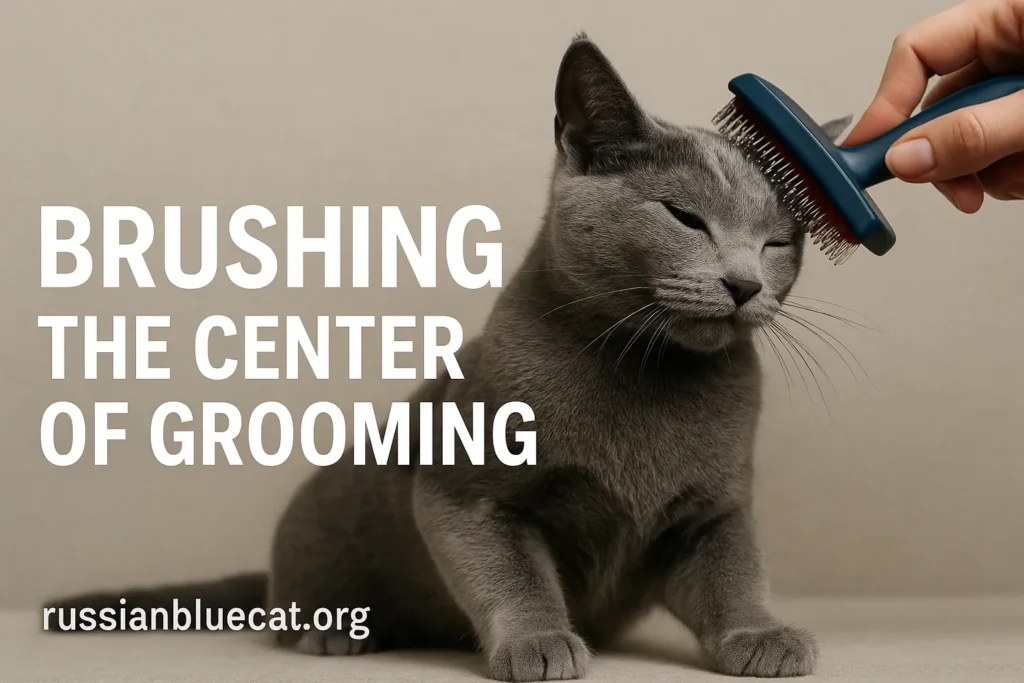
How Frequently Should You Brush?
Throughout most of the year, brushing 2–3 times weekly is best. Spring and fall shedding seasons require a daily brushing boost.
Which Brushes Are Best?
- Slicker Brush: Works well to strip undercoat hair.
- Rubber Grooming Glove: Transforms brushing into petting sessions.
- Fine-Tooth Comb: Ideal for smoothing out after brushing.
How to Make Brushing Easy
Russian Blues are timid. Begin brushing when they are calm post meals or play. Hold initial sessions to 5 minutes or less and then extend gradually. End always with praise or a treat.
Brushing is not merely about fur; it’s about building trust. Most owners report that once brushing is a habit, their cats even seek it out for reassurance. Have you checked our detailed guide on Russian Blue Cat Characteristics.
Bathing: Occasional but Worth It
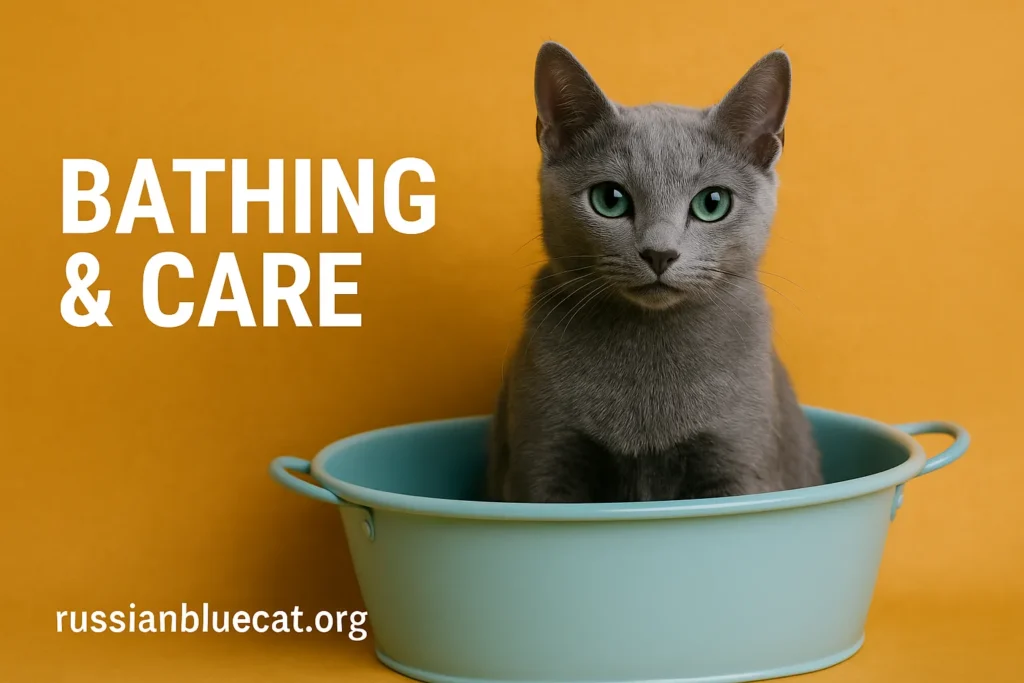
Do Russian Blues Require Baths?
Unlike Persians, Russian Blues do not require baths often. Their self-grooming is impressive. But a bath every 3–4 months resets the coat, minimizes allergens, and aids in grooming during shedding periods.
Bathing Guide for Owners
- Preparation: Position a non-slip mat in the bathtub.
- Water: Lukewarm only.
- Shampoo: Use mild, cat-specific shampoo.
- Rinsing: Be thorough; residue is irritating to skin.
- Drying: Wrap gently in a towel; never use loud dryers.
Alternatives to Water Baths
If your Russian Blue dislikes water, try grooming wipes or waterless sprays. These keep them clean without the anxiety of immersion.
Nail Trimming: Little Deed, Great Consequence
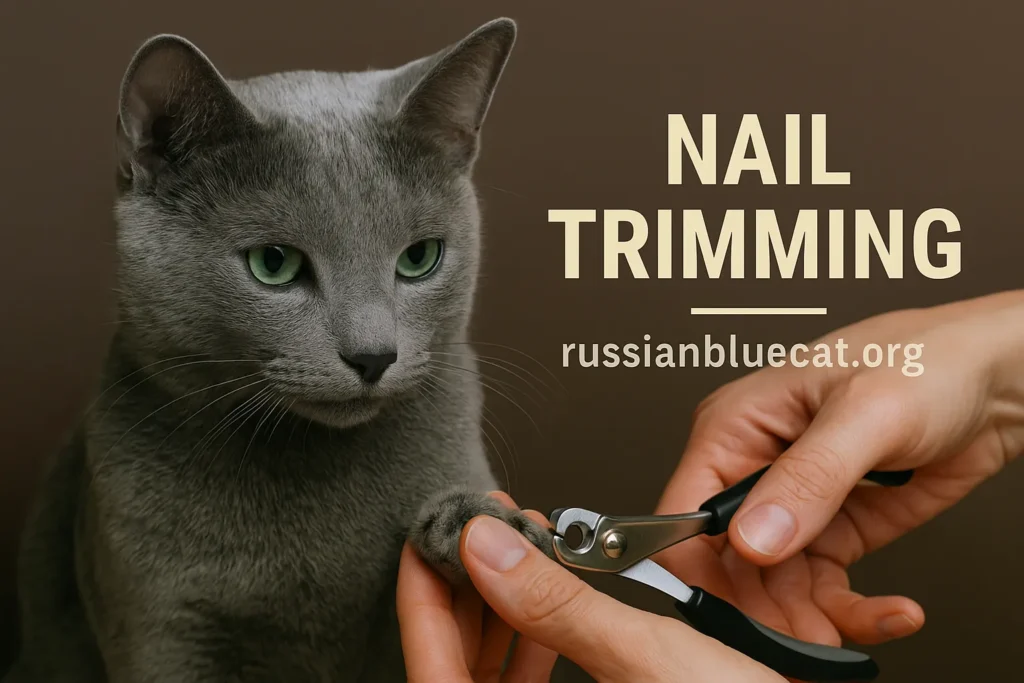
Why It’s Essential
Long nails are painful, scratch, and even become infected. House Russian Blues particularly require monthly trimming.
How to Trim Properly
- Use cat nail clippers.
- Cut just the sharp end; don’t touch the quick.
- Keep tranquil, doing a few nails at a time if necessary.
Numerous owners incorporate trimming as part of Russian Blue Cat grooming after playtime when cats are exhausted and less combative.
Ear and Eye Care
Although Russian Blues hardly ever get ear infections, monthly inspections are advisable. Utilize a vet-approved ear cleaning solution and cotton ball. For eyes, a gentle dampened cloth suffices to clean rare discharge. Their stunning emerald eyes need very little other than gentle care.
Dental Grooming: The Often Overlooked Necessity
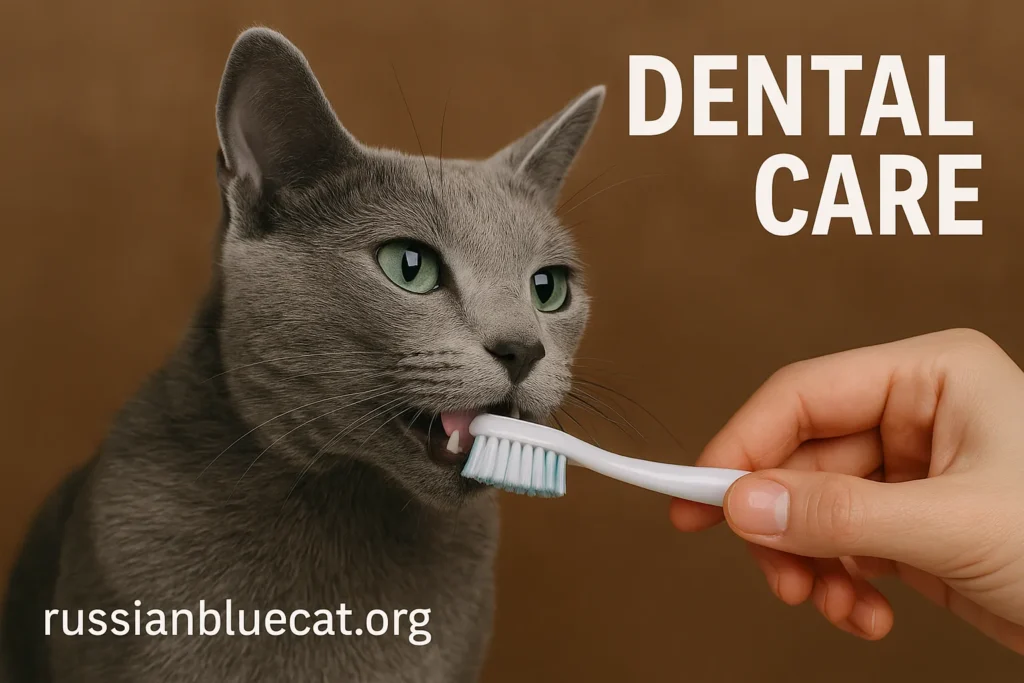
Why It Matters
Dental issues are stealthy but debilitating. Tartar formation leads to gingivitis, sensitivity, and even systemic infections.
Simple Steps for Dental Care
- Brush with cat-safe toothpaste twice a week.
- Provide dental treats for everyday maintenance.
- Book yearly veterinarian cleanings.
Owners confess that dental care is the most challenging aspect of grooming. Begin slowly have your cat lick the toothpaste first, then gradually move to soft brushing.
Grooming During Shedding Seasons
Russian Blues shed moderately throughout the year but heavily during spring and autumn. Brushing every day during these periods stops mats, manages shedding in the house, and lessens hairball development. This change of season is normal grooming just makes it workable.
Grooming and Allergies
The Russian Blue is “hypoallergenic” due to its decreased production of Fel d 1 protein. Brushing increases the advantage by lessening loose hair and dander. Brushing, bathing, and cleaning schedules simplify the lives of allergy-prone families.
Grooming Supplies Every Owner Should Stock
- Slicker brush
- Fine-tooth comb
- Rubber grooming glove
- Cat nail clippers
- Ear-cleaning solution
- Cat toothbrush and toothpaste
- Soft cloths for eye cleaning
Investing in good tools makes the grooming process easier, safer, and more enjoyable for you and your cat.
A Step-by-Step Weekly Grooming Routine
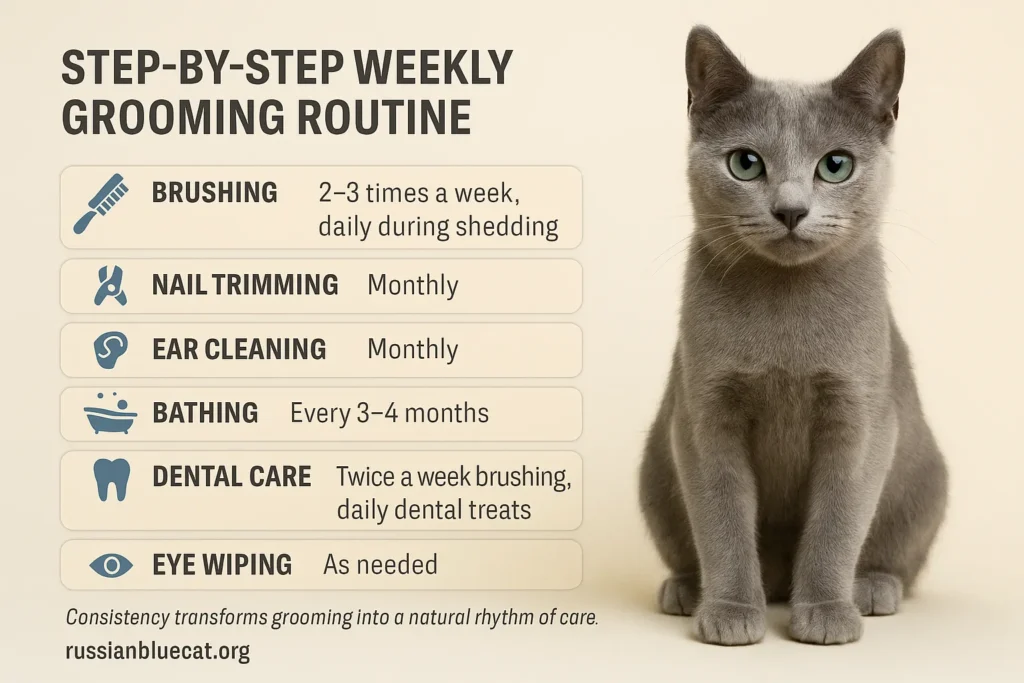
- Brushing: 2–3 times a week, daily during shedding season.
- Nail Trimming: Monthly.
- Ear Cleaning: Monthly.
- Bathing: Every 3–4 months.
- Dental Care: Twice a week brushing, daily dental treats.
- Eye Wiping: As needed.
Consistency transforms grooming into a natural rhythm of care.
Grooming as Health Monitoring
Each grooming session is also a health examination. While brushing or clipping, check for lumps, bumps, or irritation of the skin. Check for fleas, ticks, or dandruff. Finding issues early ensures long, healthy lives for Russian Blues.
Diet’s Role in Grooming Success
A healthy coat begins from the inside out. Good-quality cat food with Omega-3 and Omega-6 fatty acids encourages shine and softness. Protein aids in fur growth, and hydration avoids dry skin. Most owners can see a noticeable improvement in their Russian Blue’s coat after converting to top-quality food.
Myths About Grooming
- Myth: Russian Blues don’t require grooming.
Fact: They actually do, particularly for coat health and hairball prevention. - Myth: Cats detest grooming.
Fact: With patience and optimism, most Russian Blues love it. - Myth: Bathing is risky.
Fact: Occasional gentle baths are safe and beneficial.
Grooming Senior Russian Blue Cats
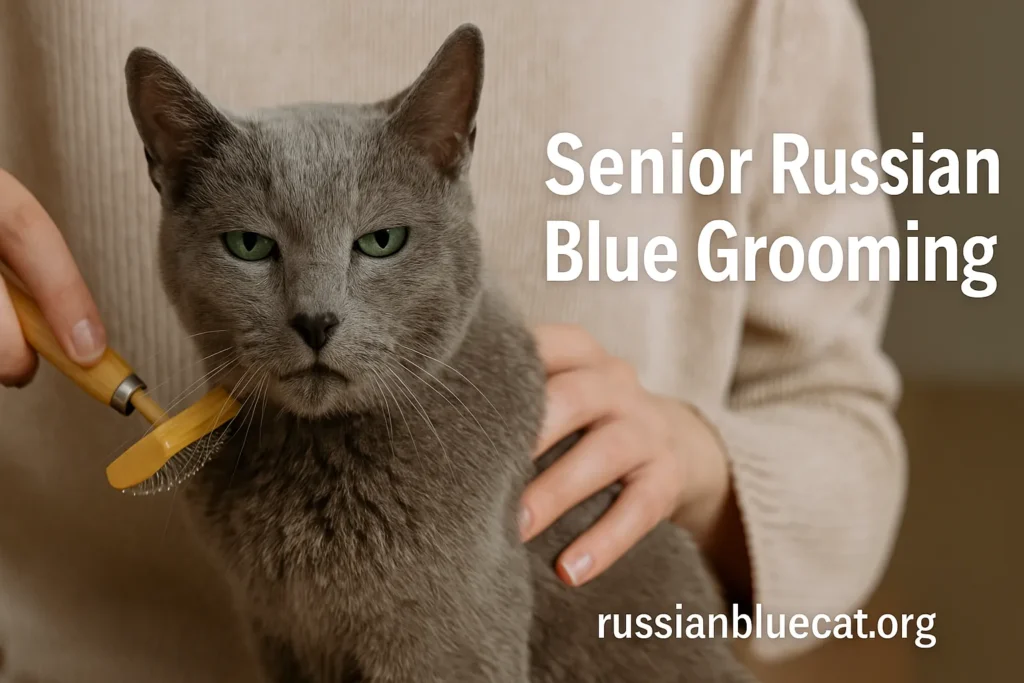
As cats get older, they may find it difficult to groom themselves. Arthritis restricts flexibility, leaving areas of the coat unwashed. Seniors require more frequent brushing, nail clipping, and dental hygiene. Gentle grooming makes them comfortable in their golden years.
For breed standard information and cat care tips, go to the American Cat Fanciers Association a reputable source of feline health and breeds.
FAQs About Russian Blue Cat Grooming
Conclusion
Russian Blue Cat grooming is not just about coat care; it’s about health, bonding, and prevention. Daily brushing, the occasional bath, nail trim, ear and eye care, and oral health keep your Russian Blue healthy at every stage of life. Grooming also strengthens your bond, making routines of care into moments of trust and love.
With love, patience, and consistency, your Russian Blue will sparkle inside and out for 20 years.






